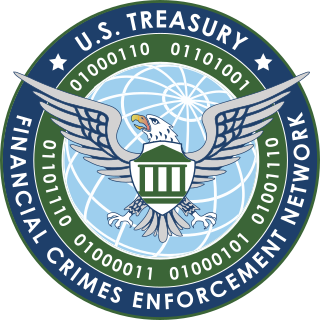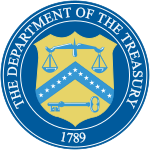
The Department of the Treasury (USDT) is the national treasury and finance department of the federal government of the United States, where it serves as an executive department. The department oversees the Bureau of Engraving and Printing and the U.S. Mint. These two agencies are responsible for printing all paper currency and coins, while the treasury executes its circulation in the domestic fiscal system. The USDT collects all federal taxes through the Internal Revenue Service; manages U.S. government debt instruments; licenses and supervises banks and thrift institutions; and advises the legislative and executive branches on matters of fiscal policy. The department is administered by the secretary of the treasury, who is a member of the Cabinet. The treasurer of the United States has limited statutory duties, but advises the Secretary on various matters such as coinage and currency production. Signatures of both officials appear on all Federal Reserve notes.

The Financial Crimes Enforcement Network (FinCEN) is a bureau of the United States Department of the Treasury that collects and analyzes information about financial transactions in order to combat domestic and international money laundering, terrorist financing, and other financial crimes.

The Office of Foreign Assets Control (OFAC) is a financial intelligence and enforcement agency of the U.S. Treasury Department. It administers and enforces economic and trade sanctions in support of U.S. national security and foreign policy objectives. Under Presidential national emergency powers, OFAC carries out its activities against foreign states as well as a variety of other organizations and individuals, like terrorist groups, deemed to be a threat to U.S. national security.
Foreign Terrorist Organization (FTO) is a designation for non-United States-based organizations deemed by the United States Secretary of State, in accordance with section 219 of the Immigration and Nationality Act of 1965 (INA), to be involved in what US authorities define as terrorist activities. Most of the organizations on the list are Islamist extremist groups, nationalist/separatist groups, or Marxist militant groups.

The Homeland Security Act (HSA) of 2002, was introduced in the aftermath of the September 11 attacks and subsequent mailings of anthrax spores. The HSA was cosponsored by 118 members of Congress. The act passed the U.S. Senate by a vote of 90–9, with one Senator not voting. It was signed into law by President George W. Bush in November 2002.

The Under Secretary for Terrorism and Financial Intelligence is a position within the United States Department of the Treasury responsible for directing the Treasury's efforts to cut the lines of financial support for terrorists, fight financial crime, enforce economic sanctions against rogue nations, and combat the financial support of the proliferation of weapons of mass destruction. The Under Secretary is appointed by the President and confirmed by the Senate.
The Terrorist Finance Tracking Program (TFTP) is a United States government program to access financial transactions on the international SWIFT network that was revealed by The New York Times, The Wall Street Journal and The Los Angeles Times in June 2006. It was part of the Bush administration's War on Terrorism. After the covert action was disclosed, the so-called SWIFT Agreement was negotiated between the United States and the European Union.
Yousser Company for Finance and Investment is a bank that was part of the first Canadian lawsuit against a bank over terrorist funding.
The Islamic Resistance Support Association is a charity used to raise funds for Hezbollah and pay for the services it offers in Lebanon.
Financial intelligence (FININT) is the gathering of information about the financial affairs of entities of interest, to understand their nature and capabilities, and predict their intentions. Generally the term applies in the context of law enforcement and related activities. One of the main purposes of financial intelligence is to identify financial transactions that may involve tax evasion, money laundering or some other criminal activity. FININT may also be involved in identifying financing of criminal and terrorist organisations. Financial intelligence can be broken down into two main areas, collection and analysis. Collection is normally done by a government agency, known as a financial intelligence organisation or Financial Intelligence Unit (FIU). The agency will collect raw transactional information and Suspicious activity reports (SAR) usually provided by banks and other entities as part of regulatory requirements. Data may be shared with other countries through intergovernmental networks. Analysis, may consist of scrutinizing a large volume of transactional data using data mining or data-matching techniques to identify persons potentially engaged in a particular activity. SARs can also be scrutinized and linked with other data to try to identify specific activity.

A United States Assistant Secretary of the Treasury is one of several positions in the United States Department of the Treasury, serving under the United States Secretary of the Treasury.

Stuart A. Levey was the first Under Secretary for Terrorism and Financial Intelligence within the United States Department of the Treasury. He was sworn in on July 21, 2004 as a political appointee of President George W. Bush. President Barack Obama asked Levey to remain in his position and Levey was one of only a small number of Senate-confirmed Bush appointees who served in the Obama Administration.
The counter-terrorism page primarily deals with special police or military organizations that carry out arrest or direct combat with terrorists. This page deals with the other aspects of counter-terrorism:

The Office of Terrorist Finance and Financial Crimes (TFFC) is an agency of the United States federal government in the United States Department of the Treasury. Under the supervision of the Under Secretary for Terrorism and Financial Intelligence, the TFFC is policy development and outreach office for the Under Secretary and works across all elements of the national security community – including the law enforcement, regulatory, policy, diplomatic and intelligence communities – and with the private sector and foreign governments to identify and address the threats presented by all forms of illicit finance to the international financial system.
The Office of Terrorism and Financial Intelligence (TFI), formed in 2004, is an agency of the United States Department of the Treasury. TFI works to reduce the use of the financial system for illicit activities by terrorists, money launderers, drug cartels, and other national security threats.
United States Intelligence Community Oversight duties are shared by both the executive and legislative branches of the government. Oversight, in this case, is the supervision of intelligence agencies, and making them accountable for their actions. Generally oversight bodies look at the following general issues: following policymaker needs, the quality of analysis, operations, and legality of actions.
Qatar has been accused of allowing terror financiers to operate within its borders, which has been one of the justifications for the Qatar diplomatic crisis that started in 2017 and ended in 2021. In 2014, David S. Cohen, then United States Under Secretary of the Treasury for Terrorism and Financial Intelligence, accused Qatari authorities of allowing financiers who were on international blacklists to live freely in the country: "There are U.S.- and UN-designated terrorist financiers in Qatar that have not been acted against under Qatari law." Accusations come from a wide variety of sources including intelligence reports, government officials, and journalists.

The Assistant Secretary for Terrorist Financing is an office of the United States government within the United States Treasury Department.

David Samuel Cohen is an American attorney who serves as the deputy director of the Central Intelligence Agency (CIA) since January 20, 2021. He also served as acting Director of the Central Intelligence Agency from January to March 2021. He previously occupied the role of deputy director from February 9, 2015 to January 20, 2017. Originally from Boston, Cohen previously worked at the U.S. Treasury Department and as an attorney in private practice. At the Treasury, among other posts, he served as the under secretary for terrorism and financial intelligence where he gained the nickname of "sanctions guru".









